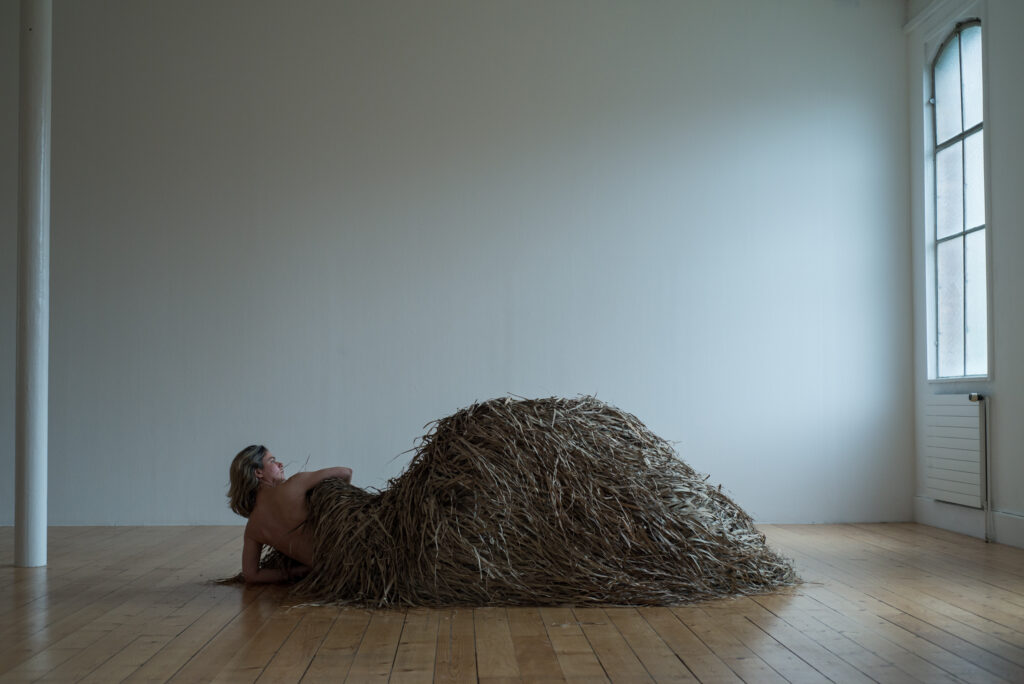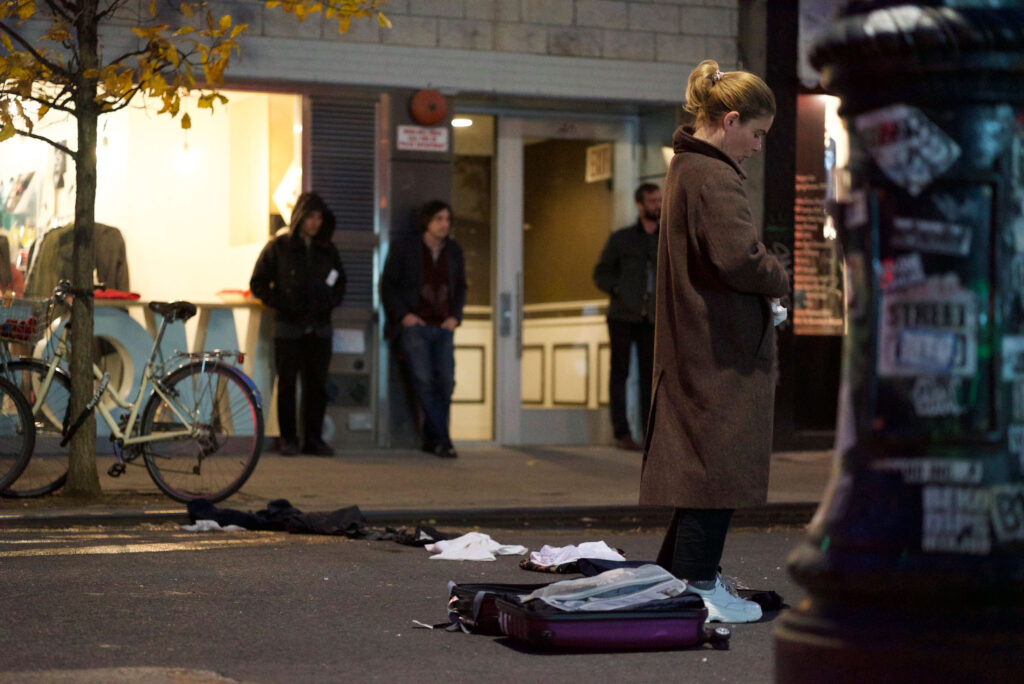
Working The no Work
2012
(…)As Silvia Federici notes in “The Great Caliban: The Struggle Against the Rebel Body,” “Marx sees the alienation for the body as a distinguishing trait of transforming labor into a commodity. The worker only feels himself outside of work, and in his work is outside himself. He is at home when he is not working and when working he is not at home. This too leads to a sense of dissociation from the body.”!
Sagri’s performance is filled with spastic eruptions of a superproductivity and hyperactivity that cannot be assimilated into any regime of rational productive activity. It’s as if the leftover dead remainders of a bodily energy dissociated from itself through the regime of work have come back to take her hostage, but have not coordinated with her in what order they will erupt, leading to an abrupt stoppage. These repetitive nuggets of strident nonsense are stark and brittle, with an almost ruthless monotone drone of repetition.
What is the effect of repetition on the audience? Does it put us in trance, like mystics who repeat the same thing over and over until they reach a revelation? No, there is no sublimation in this repetition. There is something more nihilistic and terminal about the repetition in “Travailler Je ne travaille pas (Working The Νo Work) ΔΟΥΛΕΥΟΝΤΑΣ ΤΗ ΜΗ ΔΟΥΛΕΙΑ”, bringing us to a mental “dead space”-almost like a room with no windows and no oxygen-where we are forced to confront ourselves.(…)
Andrea Liu, Georgia Sagri and the Terrible Logic of Repetition, DESTE: An Anniversary Exhibition, Museum of Cycladic Art, 2015

Shelter_Refuge
2022
“Sagri’s focus on illness, as material and precondition for an art that matters, is not derived from an understanding of disease as a private affair of ‘sick individuals’. Hers is a rather fundamental understanding that pathology is of the world; that whenever the crust of the earth is turned into a world by the actions and decisions of humans, that is the moment when the most careful and caring acts must be performed.”
André Lepecki, Breath-nest, Georgia Sagri, Case_L, 2022, Kunsthalle Friart

Semiotics of the Household
2018
“The semiotics of subjugation (subject, individual, I) and the somatics of enslavement (strength, power, bond) are part of the same disconnected economy. The living body, which gives material form to the crossroads of the semiotic and the somatic (index, individual, institution), is not attached to any specific site; it is nomadic and reactive, based on the circumstances of a state of emergency or a period of growth.”
Pierre Bal-Blanc, Episode II: Index of Household Consumption, FLASH ART 331 SUMMER 2020
A boundary drawn is never quite fixed. In the video documentation of her droll yet intensely poignant Semiotics of the Household, 2018, the artist is seen on a quiet Lower East Side street at sunset removing her possessions one by one from her wheeled carry-on suitcase, right down to her cosmetics and passport, and using them to draw a line across the street before packing them up and repeating the process. Aux barricades indeed; the personal is political, even the toiletries. Sagri’s act temporarily, gently impedes the flow of traffic; a blockage in the system is created—a minor-key reprise of, say, the occupation of a city park. Reaction from drivers is generally patient; even a garbage truck waits unhonking for her to move out of the way. But after an hour, the NYPD arrives and summarily finds a reason to handcuff a woman with a thick accent acting aberrantly in public. While her responses to the police’s queries are mostly smiling and blandly circular, when the cuffs go on she appears to break character for just a moment, declaring to an off-camera friend, “I cannot be arrested,”hinting at the visa troubles she had after Occupy.
Domenick Ammirati, CHAOS CÉLÈBRE, ARTFORUM NOVEMBER 2019
Flashing lights go on and off in the still-blue Manhattan night. In the video’s last scene, which re-creates a Georgia Sagri performance in the middle of Hester Street, in SoHo, in November 2018, New York City policemen unshackle the wrists of the artist they have just arrested, reminding her that she must have prior authorization to perform in a public place. That afternoon, the artist, whose performance was announced as taking place in Essex Street gallery, decided to break with the expectations of a captive contemporary art audience. She took the step of performing outside the exhibition venue, which uses preestablished codes to assess any act taking place within it. On the other hand, she offered her gestures both to passersby and to people visiting the gallery, who crossed paths with her on their way. For three hours, she would conscientiously carry out repetitive tasks in compliance with her program. Plunging into a bustling throng, Sagri pursued her course, no more no less, which every person in the street adopted at that time. The artist began by dragging her suitcase on wheels behind her along the sidewalk, the way all low-cost transport users and other people do to get to their private rental accommodation. For a period, which the video12 only re-creates one hour of — in keeping with the video captured by people who witnessed the scene, who gave these sequences to the artist — Sagri came up with several procedures to shape the behavior of the neoliberal individual. Her conduct stemmed from an economic analysis, responding in a systematic way to alterations in the environment’s variables. She would start by gauging the weight of her luggage, held vertically in relation to the body, before giving it a horizontal trajectory along which, after having launched it, it would come to a standstill through its own inertia. Like an investment portfolio, she took her kit (clothes, a make-up bag, props) out of her luggage and lined it all up on the public thoroughfare. This exercise would be repeated several times in different directions, to underscore or, conversely, withstand the dynamic peculiar to the urban environment she was in. The market behavior whereby everyone pursues their own agenda was just a foothold, akin to the skateboarder she crossed paths with, cars parking or slowing to let her past, and sanitation workers collecting rubbish. Sagri’s somatic exploration controls the movement of a scene based on a mistimed rational order, whose aberration can only be interrupted by traffic police.
The semiotics of the household space faced by the artist are no longer reduced to the kitchen area, or even to a gender or a particular minority, as was the case in Martha Rosler’s Semiotics of the Kitchen (1975).
Pierre Bal-Blanc, Episode II: Index of Household Consumption, FLASH ART 331 SUMMER 2020
These large cocoons or shelters are ‘based on the idea of refuge or shelter’. Because they are made of woven palm leaves and water hyacinth, they remind me more of nests. In the history of art, no one has articulated more clearly the direct relation between nests, shelters, modes of existing, queer sociability and world-making than the Brazilian Hélio Oiticica. In a way, Sagri’s cocoons-as-refuge are an interesting materialisation of an afterlife of Oiticica’s nests. They make a world as much as they ‘disorient history’, as Georges Didi-Huberman describes the operation of an image’s ‘survival’ or recurrence in art history. Sagri’s cocoons participate of this anarchism of temporal unidirection. They install another time.
[...]
Her desire to affirm ‘spiritual anarchism’ as an experimental dimension of existence requires the aspiration that the whole world become a sheltering-nest. Once that happens, we can then engage in all sorts of ‘propositions for free experimentality’. This sheltering-world is no longer public or private, but always a ‘Shelter of behavior at the experimental level: more than a refuge, it is the search for a chance of experimenting existentially’, as Oiticica wrote. Or, in Sagri’s only at first glance contradictory words: ‘spiritual anarchism’. A dimension, a body, a life profoundly enfleshed, courageously decisive,collectively breathing with the earth.
André Lepecki, Breath-nest, Georgia Sagri, Case_L, 2022, Kunsthalle Friart